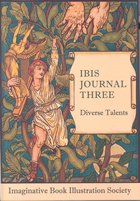The CCAD Library houses a variety of historic books and magazines related to illustration.
If there is a public domain copy of the book on the internet or an information page, we will link to it.
Viewing Special Collections materials is by appointment only. Contact library@ccad.edu.
 IBIS journal
IBIS journal
 Studies in Illustration
Studies in Illustration
 Image: The New England primer : to which is added the shorter catechism, 1820 (first printing 1690)
Image: The New England primer : to which is added the shorter catechism, 1820 (first printing 1690)Caricature and Social Illustration

Literature and Book Illustration
 Image: Kate Greenaway pictures from originals presented by her to John Ruskin and other personal friends (hitherto unpublished), 1921
Image: Kate Greenaway pictures from originals presented by her to John Ruskin and other personal friends (hitherto unpublished), 1921History, Travel, and Nature
 Image: Costume of China, George Henry Mason, 1800
Image: Costume of China, George Henry Mason, 1800Illustrated Magazines
 Image: Moderne Kunst in Meisterholzschnitten [Modern Art in Master Woodcuts], 1895
Image: Moderne Kunst in Meisterholzschnitten [Modern Art in Master Woodcuts], 1895 Image: Fairy flowers; nature legends of facts & fantasy by Isidora Newman, illustrations by Willy Pogany, 1926
Image: Fairy flowers; nature legends of facts & fantasy by Isidora Newman, illustrations by Willy Pogany, 1926 Illustration and the First World War (1914-1918)
Illustration and the First World War (1914-1918)
 Image: The Sleeping Beauty, illustrated by Arthur Rackham, 1920
Image: The Sleeping Beauty, illustrated by Arthur Rackham, 1920 Image: Underground graphics, Graham Keen, 1970
Image: Underground graphics, Graham Keen, 1970 Big Little Books, first published during 1932 by the Whitman Publishing Company of Racine, Wisconsin, were small, compact books designed with a captioned illustration opposite each page of text. Other publishers, notably Saalfield, adopted this format after Whitman achieved success with its early title. They were typically 3+5⁄8 in (92 mm) wide and 4+1⁄2 in (110 mm) high, with 212 to 432 pages making an approximate thickness of 1+1⁄2 in (38 mm). The interior book design usually displayed full-page black-and-white illustrations on the right side, facing the pages of text on the left. Stories were often related to radio programs, comic strips, children's books, novels and movies.
Big Little Books, first published during 1932 by the Whitman Publishing Company of Racine, Wisconsin, were small, compact books designed with a captioned illustration opposite each page of text. Other publishers, notably Saalfield, adopted this format after Whitman achieved success with its early title. They were typically 3+5⁄8 in (92 mm) wide and 4+1⁄2 in (110 mm) high, with 212 to 432 pages making an approximate thickness of 1+1⁄2 in (38 mm). The interior book design usually displayed full-page black-and-white illustrations on the right side, facing the pages of text on the left. Stories were often related to radio programs, comic strips, children's books, novels and movies.
We have:
 Underground comix are small press or self-published comic books that are often socially relevant or satirical in nature. They differ from mainstream comics in depicting content forbidden to mainstream publications by the Comics Code Authority, including explicit drug use, sexuality, and violence. They were most popular in the United States in the late 1960s and 1970s, and in the United Kingdom in the 1970s.
Underground comix are small press or self-published comic books that are often socially relevant or satirical in nature. They differ from mainstream comics in depicting content forbidden to mainstream publications by the Comics Code Authority, including explicit drug use, sexuality, and violence. They were most popular in the United States in the late 1960s and 1970s, and in the United Kingdom in the 1970s.
Robert Crumb, Gilbert Shelton, Barbara "Willy" Mendes, Trina Robbins and numerous other cartoonists created underground titles that were popular with readers within the counterculture scene. Punk had its own comic artists like Gary Panter. Long after their heyday, underground comix gained prominence with films and television shows influenced by the movement and with mainstream comic books, but their legacy is most obvious with alternative comics.
We have:
 Nemo: the Classic Comics Library was a magazine devoted to the history and creators of vintage comic strips. Created by comics historian Rick Marschall, it was published between 1983 and 1990 by Fantagraphics.
Nemo: the Classic Comics Library was a magazine devoted to the history and creators of vintage comic strips. Created by comics historian Rick Marschall, it was published between 1983 and 1990 by Fantagraphics.
Nemo ran for 31 issues (the last being a double issue) plus one annual. Most issues were edited by Marschall. The title was taken from the classic comic strip Little Nemo. While some issues were thematic, most were a mix of articles, interviews, comic strip reprints and more. We have the following issues:
 A minicomic is a creator-published comic book, often photocopied and stapled or with a handmade binding. In the United Kingdom and Europe the term small press comic is equivalent with minicomic, reserved for those publications measuring A6 (105 mm × 148 mm) or less.
A minicomic is a creator-published comic book, often photocopied and stapled or with a handmade binding. In the United Kingdom and Europe the term small press comic is equivalent with minicomic, reserved for those publications measuring A6 (105 mm × 148 mm) or less.
Minicomics, sometimes called ashcan copies, and sometimes zine comics, are a common inexpensive way for those who want to make their own comics on a very small budget, with mostly informal means of distribution. A number of cartoonists — such as Jessica Abel, Julie Doucet, and Adrian Tomine — have started their careers this way and later gone on to more traditional types of publishing, while other established artists — such as Matt Feazell and John Porcellino — continue to publish minicomics as their main means of production.
We have:
